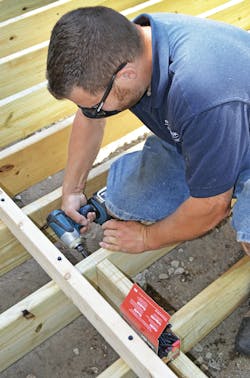Owner, Archadeck of Suburban Boston
Burlington, Mass.
I started using FastenMaster’s LOK screws after seeing them at a trade show. I’ve found that they have more uses than many contractors realize.
My company builds decks and porches, so using LedgerLOK to fasten ledgers to the house frame was enticing. At first, however, I was skeptical. Can a ¼-inch-diameter screw really be as strong as a ½-inch lag screw? Yes, according to my structural engineer. This is because predrilling a bolt hole weakens the wood, but with no holes, LOK screws act like nails. They compress the wood around them and create a stronger connection.
To be safe, we use three LOKs wherever we wold have installed a pair of lags or bolts, but still do the job much faster.
We were soon using them wherever two framing members needed to be pulled together. We framed a porch in our show-room with double rafters at each gable, but one of them warped and pulled away from its mate. A single HeadLOK screw pulled the offending rafter straight.
LOKs also help with wind uplift on porch roofs. Angling 6-inch TimberLOKs up through the wall plates into the rafters meets code and is much faster than installing hurricane clips. We use a new technique to tie our wall beam to 4x4 posts: a 12-inch HeadLOK driven down through the beam into the post below.
On deck frames, we even devised a way of using LOKs to make all the joists perfectly flat. We lay a straight 2x4 on edge across the frame, then drive 6-inch TimberLOKs through it to pull the joists flush. Staggered blocking is cut to fit between the joists and fastened with pairs of HeadLOKs driven through the joists into each block. The result is a flat deck with less deflection and no squeaks

